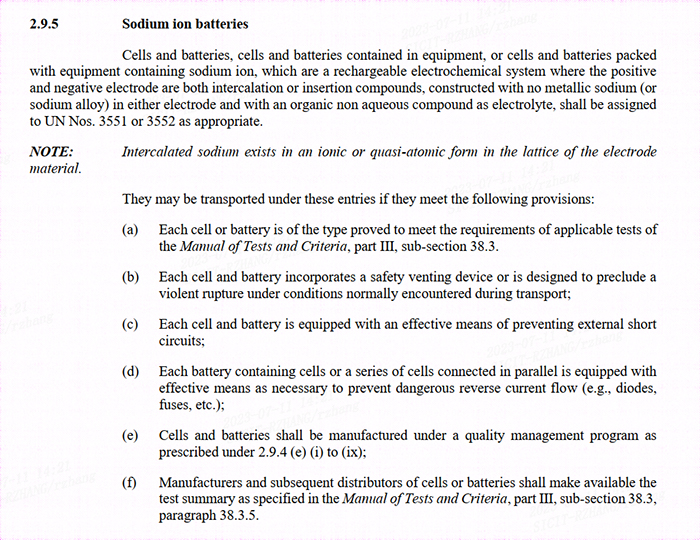

86 755 2523 4088

service@agccert.com


86 755 2523 4088

service@agccert.com

 Release Time:2023-08-21
Release Time:2023-08-21 Recently, the two major international transport organizations have updated the regulations on the transport of dangerous goods, incorporating or planning to include the transport requirements of sodium batteries in the transport regulations: the United Nations Economic Commission on the Transport of Dangerous Goods Group released the 23rd revision of the "Model Recommendations and Regulations on the Transport of Dangerous Goods" version, the transportation requirements for sodium batteries have been written into the specification, and 2.9.5 sodium-ion batteries have been added.

In 2023, the relevant regulations on sodium-ion batteries with organic electrolytes will be formally incorporated into the United Nations regulations and standards. According to the rules of procedure among international organizations, ICAO will formally discuss the requirements for the air transport rules of sodium-ion batteries at the end of 2022. , On January 1, 2025, the transportation requirements for sodium-ion batteries will officially appear in the international air transport rules.
The following are the transportation requirements for sodium batteries in the 23rd revision of TDG regulations:
1. Each cell or type of battery is certified to comply with the applicable tests specified in Section 38.3 of Part III of the Manual of Tests and Criteria;
2. Each cell and battery is fitted with a safety vent or is designed to prevent violent rupture under conditions normally encountered during transport;
3. Each battery and battery is equipped with an effective circuit to prevent external short circuit;
4. Each battery containing cells or series of cells connected in parallel is equipped with effective devices (such as diodes, fuses, etc.) necessary to prevent dangerous reverse flow;
5. Cells and battery packs must be produced in accordance with the quality management programs specified in 2.9.4(e)(i) to (ix);
6. Manufacturers and downstream distributors of batteries or batteries shall provide the test summary specified in Section 38.3.5 of Section 38.3 of Part III of the Manual of Tests and Standards.

The shipping numbers for sodium batteries are as follows:
lUN3551: Sodium-ion batteries containing organic electrolytes
lUN3552: Sodium-ion batteries containing organic electrolytes installed in or packaged with equipment
lUN3558: Vehicles powered by sodium-ion batteries
New special regulations on the transportation of sodium-ion batteries:
Special Provision 400: Sodium-ion cells and batteries may be transported exempt from the other provisions of this Regulation if they meet the requirements for battery short circuit, prescribed terms, package marking drop test, equipment protection, and transport of dangerous goods.
Special Regulation 401: Sodium-ion battery cells and battery packs using organic electrolytes must be transported according to UN 3551 or UN3552 according to actual conditions, and sodium-ion batteries using aqueous alkaline electrolytes must be transported according to UN2795 Storage battery packs, wet, loaded There is lye.
Special Provision 404: If the sodium-ion battery-powered vehicle does not contain other dangerous goods, and the battery is in a short-circuit state and does not contain electrical energy, and the short-circuit method is easily certified, it can be exempted.
Special Provision 405: Vehicles that are not fully enclosed with packing crates or other methods that prevent immediate identification are exempt from the labeling requirement, meaning that such products do not need to post a No. 9 style label.
Added packaging instruction P912
P912 is applicable to the transportation of vehicles with UN numbers 3556, 3557 and 3558. It stipulates that the vehicle should be fixed in a strong outer package, and the container structure should prevent accidents from happening to avoid battery damage caused by changes in the direction of the vehicle during transportation. It is clearly stipulated that the battery on the vehicle should not be damaged. Removal is allowed, and the remaining parts can be removed to suit packaging requirements. Such goods do not need to be tested for packaging.
Original link: https://unece.org/transport/dangerous-goods/un-model-regulations-rev-23
On August 1, 2023, the British government officially announc...
On May, 2023,the International Standards Organization (ISO)...
On June 14, 2023,The ECHA has added two new chemicals to th...
On March 9, 2023, the "Bluetooth v5.4 and QEP v4 seminar" or...
The UK Battery Act follows the principles of Extended Produc...
Royal Decree No. 110/2015 on Waste Electrical and Electronic...


Does the article solve your problem